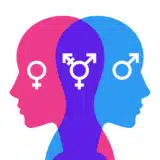What is Sexuality?
Sexuality is the pattern of your romantic, emotional or sexual attraction. Your sexual orientation is separate from your gender and is what typically becomes one of the greatest pulls through life.
At its most basic, sexuality involves the capacity to experience sexual feelings. However, it is far more than just these sensations. It encompasses our sexual orientations, identities, roles, and activities.

It has implications for our emotional health, interpersonal relationships, personal fulfillment, and even societal structures.
The Different Types of Sexuality:
Sexuality is incredibly varied and diverse. Sexuality works like a great spectrum, coming in so many different shapes and sizes.
As such it is often easier for people when asked where they fit in this spectrum to say simple and well known answers such as heterosexual, homosexual, gay, queer, fluid, asexual etc. however their actual identity might be slightly or even significantly different. In fact sexuality is so complicated, discovering ones sexuality may take many years.
The lack of role models can often retard or even confuse this process resulting in an incorrect sexuality being chosen.As a general rule however most people, over time, end up landing close to their comfortable sexual identity target.
On the flip side there are also arguments that many who identify as heterosexual are off the mark or simply dont know any better, due to a lack of information or stimuli in today’s heteronormative society. This is duplicated for gender identity where male and female are usually referred to as the only gender markers.
Gender identity and gender expression are as varied as sexual identity and the lack of general recognition leaves some in society unsure of their true identity or afraid to express it openly.
Although the vast majority of people are, not everyone is a sexual being. It is important to remember that making assumptions about other people’s gender or sexual orientation is meaningless in the face of their own. Both gender and sexual orientation belong solely with the individual.
The Spectrum of Sexuality
Sexuality has evolved considerably over time, moving away from a binary perspective to recognizing a broad, diverse spectrum of sexual orientations. Let’s delve deeper into the various types of sexuality that exist on this spectrum.
Heterosexuality
Often described as ‘straight’ sexuality, heterosexuality is characterized by the sexual and romantic attraction between individuals of opposite genders.
It is the most recognized and prevalent sexual orientation in most societies due to the predominance of heteronormative beliefs. However, this does not negate the existence and validity of other sexual orientations.
Homosexuality
Homosexuality is a term used to describe individuals who are sexually and romantically attracted to others of the same gender. Men who identify as homosexual are often referred to as ‘gay’, while women may use the term ‘lesbian’.
Despite facing social stigma and legal challenges in some societies, homosexual individuals and communities strive for recognition and acceptance.
Recommendation: Is My Brother Gay? How To Deal With A Gay Sibling
Bisexuality
Bisexuality is the sexual and romantic attraction to both males and females. It’s important to note that this attraction doesn’t have to be equally balanced or static.
A bisexual individual might experience varying levels of attraction to different genders at different times. This fluidity is a key aspect of bisexuality and reinforces the concept of sexuality as a spectrum.
Asexuality
A persistent absence of sexual attraction to either gender is a sign of asexuality. This does not automatically imply a lack of emotional ties or romantic aspirations.
Without the need for sexual attraction, asexual people can develop deep emotional connections and have committed relationships.
Queerness and Fluid Sexuality
Those who do not fit into conventional conceptions of sexuality and gender frequently use “queer” as an umbrella term. It comprises a range of gender identities and sexual orientations that contradict the heteronormative paradigm.
Another crucial principle is fluid sexuality, which refers to the notion that one’s sexual desire may alter over time, reinforcing the idea that one’s sexual identity is not static but rather fluid.
A more accepting and compassionate society is promoted by having an awareness of the sexuality spectrum. An essential first step in understanding and accepting diverse sexual orientations is sexual orientation diversity.
Recommendation: LGBT Culture
Society’s Impact on Sexuality
Our society greatly influences our views and understanding of sexuality. Various factors such as societal norms, cultural values, media, and education, converge to shape our perspectives on sexuality.
Societal Norms
Societal norms, especially heteronormativity, heavily influence our perceptions of sexuality. Such norms can marginalize non-heterosexual orientations, pressuring individuals to conform.
Cultural Influence
Cultures worldwide impact our sexuality understanding, with some being accepting while others are restrictive. These attitudes dictate how individuals experience and express their sexuality.
Media’s Role
Media shapes societal views on sexuality, either reinforcing stereotypes or promoting diversity. LGBTQ+ presence on broadcast television is at an all-time high, according to GLAAD’s 2020 study, signaling a positive change.
Importance of Education
Education, particularly comprehensive sex education, is crucial in shaping our understanding of sexuality. Despite its importance, as per a 2019 report by the Guttmacher Institute, only 30 states mandate sex education, and fewer require LGBTQ+ inclusivity.
Societal Pressure
Societal pressure often impacts individuals’ exploration and acceptance of their sexuality, suppressing true sexual orientation due to fear of judgment or discrimination. Yet, societal attitudes are gradually moving towards greater acceptance of diverse sexualities.
Society significantly shapes our understanding of sexuality. Promoting open dialogues, inclusive education, and acceptance can ensure individuals feel supported in exploring and expressing their sexuality.
Recommendation: Relationships
What is Gender Identity?
Gender identity isn’t just about being a man or a woman. It’s about how we perceive ourselves, how we feel inside. It’s a deeply rooted sense of self, an internal compass guiding us in expressing our unique identity.
Beyond the Binary
Remember when we were kids and believed everything was black or white? But then, as we grew up, we discovered the beautiful array of colors that fill the world. Much like our understanding of colors, our comprehension of gender isn’t strictly confined to ‘male’ or ‘female’. The reality of gender identity is a rich spectrum teeming with diverse identities.
Uniquely You
Understanding gender identity is like embarking on a personal journey and exploring self. It’s about acknowledging and honoring your unique experiences, emotions, and perceptions. It’s about proudly owning your identity and courageously expressing it. Remember, your gender identity is your story; only you hold the pen.
Gender identity is a deeply personal, intricate, and vibrant aspect of our identity. It’s not merely a label; it’s an understanding and expression of our unique selves. So, let’s continue to learn, grow, and embrace the beautiful diversity of gender identities in our world. After all, every color adds to the richness of the spectrum.
Recommendation: Compatibility
The Bottom Line
Sexuality isn’t a cookie-cutter model. It’s a vast, shimmering spectrum of diverse expressions and experiences. From heterosexuality to homosexuality, bisexuality to asexuality, and the vast range of queer identities, sexuality is as varied as the individuals who carry these identities in their hearts.
Yet, our understanding of sexuality doesn’t exist in a vacuum. It’s influenced by society’s norms, media messages, education, and cultural cues. Our exploration of sexuality is also intimately linked with our gender identity, a connection that reminds us of the complex interplay of factors that shape us.
Understanding the breadth of sexuality is about more than academic knowledge. It’s about fostering acceptance, promoting empathy, and creating a society where everyone, regardless of their sexual orientation or gender identity, can express their true selves openly and proudly.




















